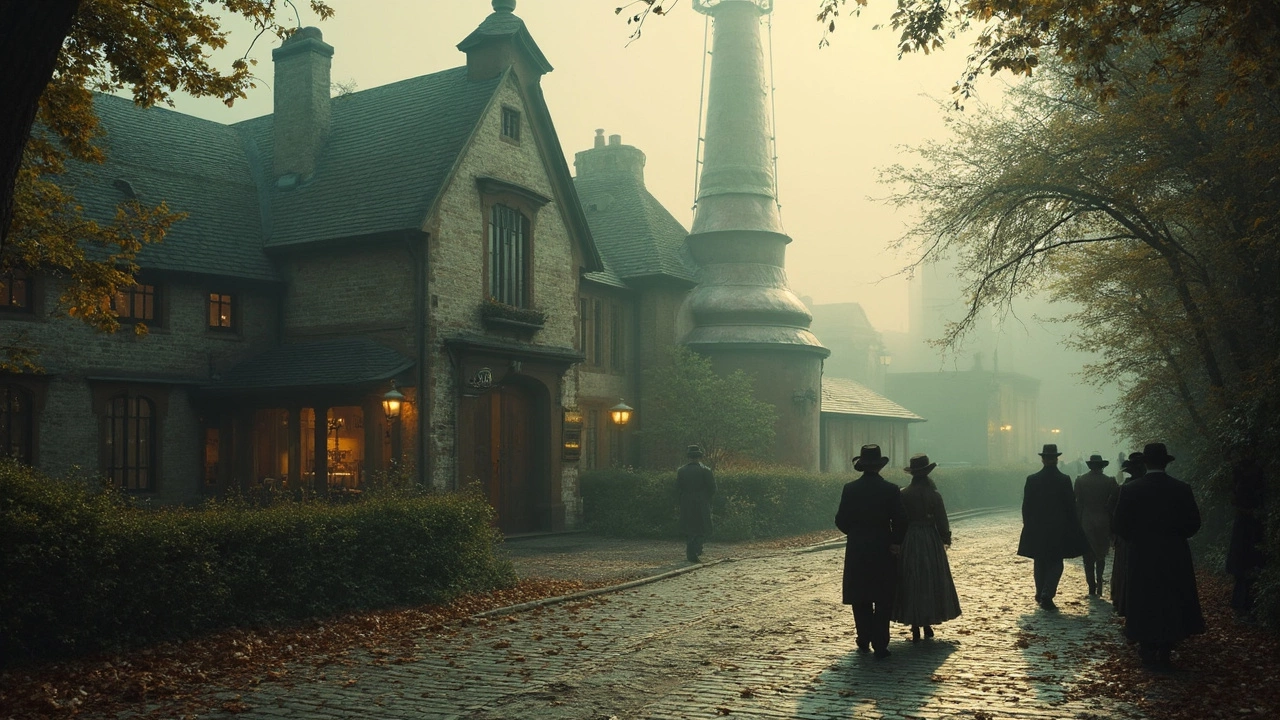If you've ever sipped gin and wondered just where it all started, you're in for a treat. Let's take a trip back in time to uncover the story behind the oldest gin brand, a tale that unravels across centuries and continents. This isn't just about a drink; it's about an entire legacy steeped in history.
The hunt for the oldest gin brand takes us to the heart of Europe, where juniper-infused spirits first caught the world's attention. What began as a medical tonic in the 17th century soon made its way into the hands of those looking to indulge in its unique flavors. But which brand can truly stake its claim as the oldest? That's the question we'll explore together.
Understanding the roots of gin not only lets you appreciate your favorite cocktail more, but it also gives a deeper insight into the traditions that shaped modern distilling. So, what makes this ancient brand stand out in a sea of new wave craft gins? And why should it be at the top of your must-visit list for your next distillery tour? These are some of the things we'll dig into in our journey.
- The Origins of the Oldest Gin Brand
- Key Historical Milestones
- Distillery Tours: Walking Through History
- The Craftsmanship Behind the Legacy
- Unique Characteristics of the Oldest Gin
- Modern-Day Relevance and Trends
The Origins of the Oldest Gin Brand
The story of gin begins in the cool climates of 17th century Europe, where juniper berries were used not just for flavor, but also for their supposed medicinal properties. People were convinced these potent berries could cure all sorts of ailments. The oldest gin brand that still graces our bars today can trace its roots back to this era.
It all kicked off in the Netherlands, where a Dutch physician named Franciscus Sylvius is largely credited with the creation of 'genever', a precursor to the gin we know and love. The idea was to distill malt wine with juniper to create a medicine, but it didn't take long for folks to start enjoying it as a recreational drink.
The gin craze took England by storm when British soldiers brought back this 'Dutch Courage' around the late 1600s. This led to the birth of the oldest surviving gin brand, and while records can be a bit hazy from those times, one name that stands out is Plymouth Gin, established in 1793. They set up shop in a former monastery on the coast of England, and they've kept up with the craft to this day.
Plymouth Gin quickly became a staple, not only because it tasted great but because it was also more refined and consistent compared to other options of the time. If you ever take a sip, you might notice its distinct, slightly sweeter taste, owing to its unique brewing process that truly set the standard.
The gin landscape back then was a wild west of trial and error, but those pioneers laid the foundation for what would become a global sensation. As we sip our way through history, it's clear that this enduring brand left an unshakeable mark on the world, making it a must-see on any serious gin distillery tour.
Key Historical Milestones
Diving into the key stages of the oldest gin brand is like flipping the pages of a time-worn book, each chapter providing a glimpse into its storied past. One of the first major milestones goes back to the 1600s, when gin emerged as a popular spirit in the Netherlands, known as 'genever.' This was the humble beginning of what would evolve into the gin we enjoy today.
A significant turning point came in the early 1700s. The Dutch were already producing gin, but it was the English who embraced it with fervor, giving rise to what's known as the 'Gin Craze' in London. At this time, gin wasn't just a drink; it played a role in social upheaval and saw consumption skyrocket, leading to various 'Gin Acts' meant to control its production and distribution.
Fast forward to the 1800s, the oldest gin brand began to truly carve out its legacy. With the introduction of new distillation techniques, such as the continuous still, the quality and consistency of gin improved dramatically, allowing distillers to produce more refined and flavorful gin, as we know it today.
- 1600s: Birth of gin as genever in the Netherlands
- 1700s: 'Gin Craze' in London, sparking legislation to regulate gin
- 1800s: Advancements in distillation improve gin quality
In the 20th century, gin continued to evolve. The brand endured through Prohibition in the United States by pivoting its market strategies and maintaining its quality. Meanwhile, cocktail culture flourished, embedding gin into popular drinks that remain classic choices today.
By the time the 21st century rolled around, gin had become a versatile spirit cherished globally. The oldest gin brand wasn't just a relic of the past but a living testament to innovation and tradition, offering classic recipes alongside new-age creations to cater to modern palates. So, when you're sipping on your next G&T, remember you're part of a rich tapestry woven over hundreds of years.
Distillery Tours: Walking Through History
Ever thought about what it's like to walk through a time capsule of gin-making? Well, you're in for something special when you visit the iconic distilleries behind the oldest gin brand. These tours aren't just about seeing where spirits are made; they’re a full-on journey into the past.
For starters, picture strolling through the cobblestone pathways that have seen centuries of bustling activity. The walls of these distilleries tell stories of craftsmanship passed down through generations. It's like stepping into an old-world tale where every corner is steeped in tradition.
One of the standout distilleries you might visit still uses original copper pot stills, which have been producing gin since the 1700s. Seeing these in action isn't just for history buffs; it's fascinating to see how these time-honored techniques contribute to the gin's unique flavor.
And it's not just about looking around. Many distillery tours offer tasting sessions where you get to sample products, including limited editions only available at the site. It's a chance for your taste buds to experience a bit of history.
- Explore centuries-old distilling equipment and learn about traditional methods.
- Participate in guided tastings with local gin experts.
- Discover the stories behind iconic gin bottles and branding.
Visiting a distillery gives you a front-row seat to the meticulous process that goes into creating each bottle. Understanding the artistry behind the oldest gin brand will deepen your appreciation of every sip. Plus, it’s an unforgettable day out, offering you not just gin, but a slice of history that's still very much alive today.

The Craftsmanship Behind the Legacy
When it comes to creating the world’s oldest gin brand, it's not just about following a recipe. The magic lies in the meticulous craftsmanship passed down through generations. There's a fascinating mix of tradition, precision, and artistic flair that goes into every bottle.
First, let’s talk about the ingredients. Using only the finest juniper berries is crucial. These berries are the heart and soul of gin, providing that distinctive piney flavor. The master distillers also select a carefully curated blend of botanicals that may include coriander, angelica root, and citrus peels. This medley gives each sip its complex and aromatic profile.
The distillation process itself is something of an art form. Traditional copper pot stills are used, which not only help purify the spirit but also add subtle characteristics that set the oldest gin apart from its peers. The distillers watch the process like hawks, making sure temperature and timing are just right to capture the essence of their unique recipe.
The aging and blending stages also demand precision. Some gins are aged in oak barrels, which can impart rich, woody notes. The blending process is equally critical; it ensures consistency and allows the unique flavor profile to shine through in every batch.
For those interested in the nitty-gritty details, check out the table below, which provides a glimpse into the exact timeframes and unique botanicals used by the oldest brand:
| Process Stage | Detail |
|---|---|
| Botanical Selection | Juniper, coriander, citrus peels |
| Distillation Time | 6-8 hours |
| Aging Period | 6 months to 2 years |
It’s this unwavering commitment to craftsmanship that keeps the oldest gin brand relevant and revered today. Next time you sip on a gin and tonic, you’ll know just how much dedication goes into that refreshing glass.
Unique Characteristics of the Oldest Gin
So, what sets the oldest gin brand apart in this ocean of juniper-infused spirits? Let's talk about its distinct characteristics that have kept it in the limelight for centuries.
Firstly, there's the recipe. We're talking about a secret formula that has been passed down through generations, carefully preserved like a family heirloom. Most of these old recipes still rely heavily on juniper berries, but what makes them special is their unique blend of botanicals. Imagine hints of coriander, angelica root, and even some zest of citrus that explode in your mouth, all skillfully balanced.
Another key factor is the distillation process. This isn't just any production line—it's a craft. Traditionally, it's a pot still method, which allows for a richer and more complex flavor profile. The use of copper stills also plays a crucial role in removing impurities and enhancing the taste.
Let's not forget the aging process. While not all gins are aged, those that come from this oldest gin brand might spend some time in oak barrels, just like whisky. This adds layers of character, giving it a smoother finish. How cool is that?
What about historical significance? The oldest gin brand not only provides a tasty trip for your taste buds but also a rich history lesson. It helps connect us to a time when gin was not just a drink but a social phenomenon, impacting cultures and economies.
If you're diving into the older gins, look out for those traditional bottle designs—classic, elegant, and sometimes a nod to their historical roots. These small details add to the charm and allure of the brand.
Modern-Day Relevance and Trends
Gins have seen a delightful resurgence in recent years, and it’s fascinating to see how the oldest gin brand continues to hold its own in a world buzzing with flashy newcomers. While trends often come and go, the steadfast popularity of this classic brand is a testament to its quality and legacy.
In today's world, authenticity is a big deal, and many drinkers are drawn to brands with a rich history. That’s why the oldest gin brand has found its niche, offering both tradition and reliability. This brand keeps evolving by incorporating modern distilling techniques while staying true to its roots, making it appealing for both connoisseurs and newcomers.
Gin trends have shifted towards craft and unique flavors, with botanicals taking center stage. The oldest brand didn’t shy away from this trend; it capitalized on it by introducing limited-edition seasonal flavors that keep enthusiasts excited.
Another trend is the rising popularity of gin-based cocktails, thanks to social media platforms showcasing them as trendy and sophisticated. Whether it’s the classic G&T or edgy new creations, the flexibility of gin makes it a favorite choice. This brand, with its extensive lineage, is frequently the star in cocktail menus worldwide.
On the retail side, packaged gin sales have jumped, especially during festive seasons. Enthusiasts often seek brands with a storied past, making this iconic gin a popular gift choice. And, let's face it, there's a certain charm in gifting a bottle that comes with an epic backstory.
For the eco-conscious crowd, sustainability in gin production is gaining traction. Many distilleries, including those connected with long-established brands, are investing in greener processes, appealing to mindful consumers.
The following table showcases some relevant stats about gin's booming trend:
| Year | Global Gin Consumption (in million liters) |
|---|---|
| 2021 | 9.0 |
| 2022 | 10.4 |
| 2023 | 11.5 |
So, whether you're a gin novice or a seasoned fan, the oldest gin brand offers something for everyone. It effortlessly blends history with modern flair, ensuring its space on the top shelves of bars and in the hearts of gin lovers everywhere.


